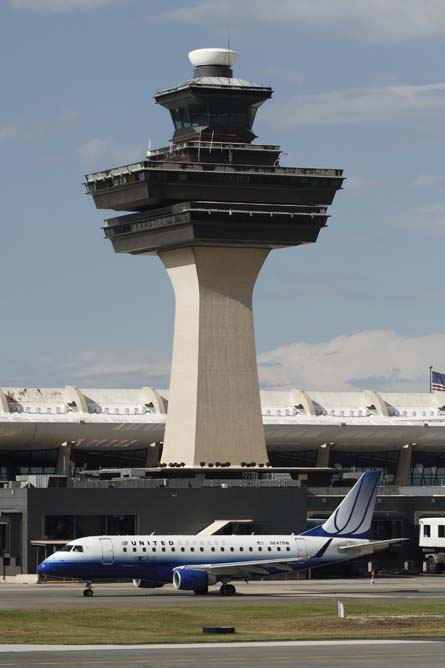Business aviation and the US government continue to develop, adopt and modify initiatives aimed at improving security while preserving its right to operate in the National Airspace System.
In the immediate aftermath of the attacks, air traffic was grounded and access to airspace and US airports restricted, particularly for general aviation. To protect the capital from terrorism, government locked the doors on access to Ronald Reagan Washington National airport (DCA), once a thriving business aviation hub.
"Before 9/11, we averaged about 100 to 125 arrivals daily and had about 20 base tenants in our hangar," says Mary Miller, vice-president of industry and government relations at Signature Flight Support, the fixed base operator for GA operations at DCA. "After 9/11, we were closed to all GA activity, except to [aircraft with] military and government waivers, which averaged two to three arrivals a day."
 |
|---|
A long drive from downtown DC, Dulles is surpassed by Washington National as a business aviation facility |
In 2000, there were 44,592 general aviation aircraft movements out of DCA. In 2002 there were only 2,255, although by 2010 this had increased to 4,788 (see table). On October 18, 2005, when the Transportation Security Administration (TSA) reopened DCA's doors a crack with the launch of the DCA Access Standard Security Programme (DASSP). The DASSP allowed limited access to the airport - Signature went to three-to-five operations a day - but its daunting requirements stopped many operators from applying, Miller says.
Doug Carr, vice-president of safety, security and regulations at the National Business Aviation Association (NBAA), details some of the restrictions. The operator must adopt a TSA-approved security programme, and flights must depart from a gateway airport approved for operations into DCA. Also, all pilots and crew must be security-vetted and as GA aircraft do not have hardened cockpits, an armed security officer (ASO) must be on board.
Miller says that "sheer tenacity" led a working group of corporate flight departments and industry to partner the TSA's Office of General Aviation in a bid to eliminate some of the processes prohibitive to flight departments. On March 11, the TSA updated procedures. Now, operators can swap tail numbers or crew members up to two hours prior to departure. And there is more leeway with arrival and departure times, depending on availability of TSA resources to conduct inspections.
Miller says Signature has started to see a "nice bump" in activity to seven to 10 arrivals daily - isolating Monday to Friday activity. "And we are optimistic more operators will be applying for certification into DCA," she says.
When the programme started in 2005, there were 12 gateway cities. There were "well over 60" on the TSA's updated list issued in mid-September, and that list is expected to increase.The biggest challenge now is the ASO requirement. Those with a security department may have a staff member qualified to serve as the ASO. For others, engaging one is prohibitively costly. "But if we can find an alternative solution, I think operators will return to DCA in the same numbers prior to 9/11," says Carr.
He stresses the importance of DCA for business aviation operators. The airport is a short hop from downtown, while Washington Dulles International is a long drive away. "Meeting DCA's stringent access requirements is a hurdle they are willing to jump because of the improved business productivity they get while in Washington," says Carr.
Change is also afoot within the Large Aircraft Security Program (LASP). The TSA has spent two and a half years reworking a proposed rule issued in October 2008. This called for operators flying aircraft with a maximum take-off weight of 12,500lb (5,700kg) or more to implement security programmes and undergo compliance audits. Operators would also have to verify passengers are not on the no-fly and/or watch lists. The commentary period closed in February 2009 and from March until June that year, the NBAA and the Aircraft Owners and Pilots Association met with the TSA to contest "several egregious elements" of the proposed rule, including the definition of a "large airplane" as one weighing 12,500lb. "Anyone familiar with our aircraft knows that a 12,500lb aircraft could literally fit sideways on any of the planes used for attacks on 9/11," says Carr.
In May, the TSA officially completed its rewrite of the LASP proposed rule, and as of mid-September was under review by the Secretary of the Department of Homeland Security. Carr says the NBAA is hoping to review those changes and provide feedback by year-end.
Switching focus to international business aviation operations, Carr says that "one of the most successful security programme introductions" is the US Customs and Border Protection Agency's web-based Electronic-Advance Passenger Information System (eAPIS). This allows for flight manifests to be uploaded or entered online and into the APIS, and applies to all flights to and from the US regardless of which country the aircraft is registered in.
In 2009, the eAPIS programme was expanded to include general aviation - pilots of private aircraft are required to electronically transmit notices of arrival/departure and traveller manifest data to the agency no less than an hour before departure through eAPIS or another agency-approved electronic data-interchange system. So far, eAPIS has had an almost 100% compliance rate and provides Customs with better information about who is onboard and where they are going, says Carr.
Previously, no one had a good indication of who was on an aircraft prior to its arrival in the USA. But now, Carr believes eAPIS negates any need for the portal entry requirement discussed in earlier proposals.
Source: Flight International




















